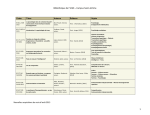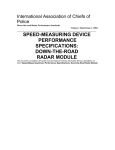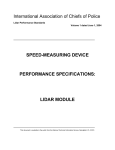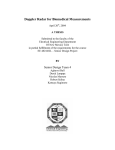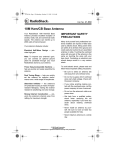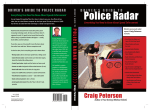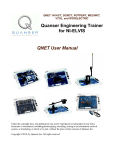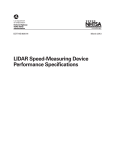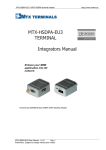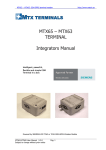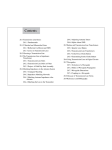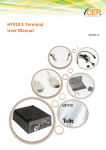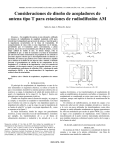Download International Association of Chiefs of Police
Transcript
International Association of Chiefs of Police 2004 Across-the-road Radar Performance Standards Volume 1 Dated June 1, 2004 __________________________________________________________________ SPEED-MEASURING DEVICE PERFORMANCE SPECIFICATIONS: ACROSS-THE-ROAD RADAR MODULE This document is available to the public from the National Technical Information Service, Springfield, VA 22161 Speed-Measuring Device Performance Specifications: Across-the-Road Radar Module FOREWORD This document contains the across-the-road radar speed-measuring device performance specifications developed under an Interagency Agreement with the National Institute of Standards and Technology, Office of Law Enforcement Standards. By defining minimum performance requirements and verification procedures, this technical document establishes a base line for acceptable across-the-road radar speedmeasuring device performance. Citizens, courts, and law enforcement officers should be assured that those across-the-road radar speed-measuring device models, determined by test to comply with these specifications, will provide the high-quality service they require. Across-the-road radar equipment buyers should use these performance specifications as a model to develop purchasing criteria. It is recommended that these specifications be incorporated into procurement documents requiring that devices offered for purchase meet, as a minimum, these specifications. Manufacturers are encouraged to produce across-the-road radar speed-measuring devices that meet or exceed these performance specifications. Because this National Highway Traffic Safety Administration (NHTSA) document is designed as a development and procurement aid, it is necessarily highly technical. These performance specifications are subject to continuing review. Technical comments and recommended revisions are welcome. Please send suggestions to: Enforcement and Justice Services Division National Highway Traffic Safety Administration 400 Seventh Street, SW, NTS-13 Washington, DC 20590 Before citing these performance specifications, or any part of them, users should verify that the most recent edition of this document is being used. NHTSA believes that these performance specifications for across-the-road radar speed-measuring devices will assist law enforcement administrators in determining the accuracy and reliability of across-the-road radar devices they plan to purchase. NHTSA also believes that these performance specifications and testing protocols will increase the confidence of law enforcement officers, the public and the courts in the accuracy and reliability of acrossthe-road radar speed-measuring devices. 6/1/04 i ii 6/1/04 Speed-Measuring Device Performance Specifications: Across-the-Road Radar Module ACKNOWLEDGMENTS The National Highway Traffic Safety Administration wishes to express its appreciation to the following individuals that have contributed to the publication of this document. A. George Lieberman, Ph.D. Program Manager, Office of Law Enforcement Standards National Institute of Standards and Technology Richard R. Larson Program Manager, Radar Testing Program International Association of Chiefs of Police Members of the Enforcement Technologies Advisory Technical Subcommittee (E.T.A.T.S.), Highway Safety Committee International Association of Chiefs of Police Appreciation is also extended to the manufacturers of across-the-road radar speedmeasuring devices for their cooperation in the preparation of this document. 6/1/04 iii iv 6/1/04 Speed-Measuring Device Performance Specifications: Across-the-Road Radar Module TABLE OF CONTENTS Page Foreword .......................................................................................................................... i Acknowledgments ...........................................................................................................iii Section 1 - General Information §1.1 Scope ........................................................................................................ 1-1 §1.2 Purpose ..................................................................................................... 1-1 §1.3 Application ................................................................................................. 1-1 §1.4 Definitions.................................................................................................. 1-1 Section 2 – Requirements §2.1 Manufacturer Provided Equipment ............................................................ 2-1 §2.2 Manufacturer Provided Information ........................................................... 2-1 §2.3 Manufacturer Labeling ............................................................................... 2-2 §2.4 Tuning Fork Calibration ............................................................................ 2-3 §2.5 Tuning Fork ............................................................................................... 2-3 §2.6 Microwave Transmission ........................................................................... 2-3 §2.7 Environmental Extremes… ........................................................................ 2-4 §2.8 Low Supply Voltage Indicator .................................................................... 2-4 §2.9 Doppler Audio............................................................................................ 2-5 §2.10 (Reserved)............................................................................................... 2-5 §2.11 Power Surge............................................................................................ 2-5 §2.12 Speed Display ......................................................................................... 2-5 §2.13 Signal Processing .................................................................................... 2-6 §2.14 (Reserved)............................................................................................... 2-6 §2.15 Conducted Electromagnetic Interference................................................. 2-6 §2.16 Radiated Electromagnetic Interference.................................................... 2-7 §2.17 Speed Accuracy: Field Operation ............................................................ 2-7 §2.18 Vehicle Determination: Field Operation Speed Measurement ................. 2-8 Section 3 - Test Conditions §3.1 Standard Test Conditions .......................................................................... 3-1 Section 4 – Test Equipment §4.1 Test Equipment ......................................................................................... 4-1 §4.2 Multifunction Synthesizer........................................................................... 4-1 §4.3 Microphone................................................................................................ 4-1 §4.4 Environmental Chamber ............................................................................ 4-1 §4.5 Anechoic Chamber .................................................................................... 4-1 6/1/04 v §4.6 Microwave Frequency Counter.................................................................. 4-2 §4.7 Field-Strength Meter .................................................................................. 4-2 §4.8 Isotropic Probe .......................................................................................... 4-2 §4.9 Line Impedance Stabilization Network (LISN) ........................................... 4-2 §4.10 Isolation Transformer............................................................................... 4-2 §4.11 Pulse Generator ...................................................................................... 4-2 §4.12 Sawtooth Wave Generator ...................................................................... 4-2 §4.13 FM Signal Generator ............................................................................... 4-3 §4.14 AM Signal Generator ............................................................................... 4-3 §4.15 RF Power Meter ...................................................................................... 4-3 §4.16 Oscilloscope ............................................................................................ 4-3 §4.17 (Reserved)............................................................................................... 4-3 §4.18 Slide Whistle............................................................................................ 4-3 §4.19 Target Simulator [5] ................................................................................. 4-4 §4.20 Instrument Turntable ............................................................................... 4-4 §4.21 Microwave Power Meter .......................................................................... 4-4 §4.22 Reference Speed Meter........................................................................... 4-4 Section 5 – Test Procedures §5.1 (Reserved)................................................................................................. 5-1 §5.2 (Reserved)................................................................................................. 5-1 §5.3 Manufacturer Labeling ............................................................................... 5-1 §5.4 Tuning Fork Calibration ............................................................................. 5-1 §5.5 Tuning Fork .............................................................................................. 5-2 §5.6 Microwave Transmission ........................................................................... 5-2 §5.7 Environmental Extremes............................................................................ 5-4 §5.8 Low Supply Voltage ................................................................................... 5-4 §5.9 Doppler Audio............................................................................................ 5-5 §5.10 (Reserved)............................................................................................... 5-5 §5.11 Power Surge............................................................................................ 5-5 §5.12 Speed Display ........................................................................................ 5-5 §5.13 Signal Processing .................................................................................... 5-6 §5.14 Reserved ................................................................................................. 5-7 §5.15 Conducted Electromagnetic Interference................................................. 5-7 §5.16 Radiated Electromagnetic Interference.................................................... 5-8 §5.17 Speed Accuracy: Field Operation ............................................................ 5-9 §5.18 Vehicle Determination: Field Operation ..................................……….…5-10 Appendix Table 1 - Speed Errors Due to Misalignment.....................................................A-2 Table 2 - Minimum Performance Specification for ATR Speed-Measuring Devices .................................................................A-3 Figure 1 - Test parameters required for the ATR target simulator .....................A-4 Figure 2 - The ATR radar target simulator [5] ....................................................A-5 vi 6/1/04 Speed-Measuring Device Performance Specifications: Across-the-Road Radar Module Figure 3 - The tuning-fork calibration setup .......................................................A-6 Figure 4 - The transmission-frequency and frequency-stability measurements setup........................................................................A-7 Figure 5 - The input current and low supply voltage measurements setup........A-8 Figure 6 - The radiated output power stability measurement setup ...................A-9 Figure 7 - The antenna beamwidth measurement setup .................................A-10 Figure 8 - The antenna near-field power density measurement setup.............A-11 Figure 9 - The simulated vehicle alternator interference measurement setup........................................................................A-12 Figure 10 - The simulated vehicle ignition, air conditioner/heater and windshield wiper interference measurements setup......................A-13 Figure 11 - The simulated police FM transceiver and the citizens band AM transceiver interference measurements setup ........................A-14 Figure 12 - The line interference stabilization network (LISN) .........................A-15 Figure 13 - The operational speed accuracy measurements setup shown for receding traffic .............................................................A-16 Bibliography 6/1/04 vii Speed-Measuring Device Performance Specifications: Across-the-Road Radar Module Section 1 - General Information 1.1 Scope The scope of this document is limited to automated, across-the-road radar systems used by law enforcement agencies for enforcing vehicle speed regulations. 1.2 Purpose The purpose of this document is to specify minimum performance requirements and methods of test for the stationary, automated, across-the-road radar devices used by law enforcement agencies to measure, display and record images of vehicles moving at excessive speeds along the nation’s roads and highways. 1.3 Applications This document applies to radar speed measuring devices that transmit an unmodulated continuous wave (CW) microwave beam across the roadway, monitor the signals reflected from the moving vehicles crossing the microwave beam, process the Doppler shifts of the reflected signals for the vehicle speeds, and may automatically record images of those vehicles which exceed a preset speed. 1.4 Definitions The principal terms used in this document are defined in this section. Additional definitions relating to law enforcement electronic items may be found in reference [2]. 1.4.1 Accuracy - the degree to which a radar device measures and displays the correct speed of a target vehicle. 1.4.2 Acquired Target - a vehicle which enters the radar beam of an ATR device, allowing for a measurement of its speed. 1.4.3 Across-the-Road Radar (ATR) Device - a radar device which operates at a specified angle to the path of vehicle(s) and which makes allowance for the cosine angle effect. 1.4.4 Ambient Interference - The conducted and/or radiated electromagnetic interference and/or mechanical motion interference, at a specific test location and time, which might be detrimental to proper radar device performance. 1.4.5. Antenna Horizontal Beamwidth - the total included acute angle, in the horizontal plane, of the main lobe between the half-power points of the radar antenna far-field radiation pattern, where the half-power points are measured relative to the maximum power at the center of the radar beam and on a radius equidistant from the face of the antenna. 6/1/04 General Information Page 1-1 1.4.6 Antenna Primary Beam - the radiation pattern of the antenna enclosed by the angle between the two first minima of radiated power on each side of the antenna centerline. The main lobe of an antenna radiation pattern excluding all microwave power radiated in the sidelobes. 1.4.7 Attended Operation – an operator is an integral part of the evidence acquisition process. 1.4.8 Cosine Effect - the effect due to the target not traveling directly toward or away from the radar device. The effect is always to lower the Doppler shift frequency in direct proportion to the cosine of the angle between the direction of travel and a line from the radar device to the target. 1.4.9 Design Angle - the angle at which the across-the-road radar device is designed to operate with respect to the path of the targeted vehicle (cf., figure 1). 1.4.10 Displacement Distance - the distance from the ATR device to the monitored lane of traffic (cf., figure 1). 1.4.11 Display - a visual readout device used to show vehicle speed and other useful information. 1.4.12 Doppler Audio - an audible signal that is generated by driving a loudspeaker with the Doppler-shift beat frequency, or with the Doppler-shift beat frequency divided by a fixed factor, provided that changes in the audio frequency correspond directly to changes in the speed of a target vehicle and any ambient interference present is discernible. 1.4.13 Doppler Shift - the magnitude of the frequency change of the radar return signal received when the source and the radar reflecting target are in motion relative to one another. 1.4.14 Erroneous Reading - an incorrect target speed displayed by the radar device, i.e., one that is not due to a target vehicle or which is not within the required accuracy tolerance of the speed of a target vehicle, excluding known correction factors such as the cosine effect. 1.4.15 Far-field Region [3] - that region beyond the close proximity of a transmitting antenna generally considered to begin at a radial distance R defined by the relationship R> 2d2 λ where d is a length characteristic of the antenna aperture and λ is the wavelength of the transmitted frequency, in consistent units. Page 1-2 General Information 6/1/04 Speed-Measuring Device Performance Specifications: Across-the-Road Radar Module 1.4.16 Frequency Band - a designation for the assigned frequency range in which the radar device operates. Current frequency assignments for police traffic radar devices are: X-band (10,500 MHz to 10,550 MHz), K-band (24,050 MHz to 24,250 MHz), and Ka-band (33,400 to 36,000 MHz). 1.4.17 Internal Circuit Test - a test function (whether manually or automatically initiated) that verifies that all radar device internal signal-processing circuitry, except for the microwave transmitter and receiver, is working correctly, i.e., all target and patrol signals will be properly processed and displayed. 1.4.18 Low-Voltage Indicator - a sensing circuit of the radar device which alerts the operator that a low supply voltage condition exists which may affect radar performance. 1.4.19 Microwave Output Power - the power produced by the microwave transmitter that is delivered to the input of the radar antenna. 1.4.20 Near-field Region - the region in close proximity to the transmitting antenna that is not included in the region defined as "far-field region." 1.4.21 Nominal Value - the numerical value of a device characteristic as specified by the manufacturer. 1.4.22 Polarization - the property of a radiated electromagnetic wave describing the time-varying direction and magnitude of the electric field vector. 1.4.23 Power Density - the amount of microwave power passing through a unit area of space measured in a plane that is perpendicular to the direction of propagation. 1.4.24 Recorded Image - images recorded on photographs, microphotographs, electronic images, videotape, or any other medium. 1.4.25 Sidelobes - radar beams from the antenna which are not part of the primary radar beam, but which may appear as shoulders on the primary radar beam. 1.4.26 Simulator - a device that generates a precisely-defined synthetic Doppler reflection for testing radar devices. 1.4.27 Squelch - the capacity of a radar device to inhibit the Doppler audio sound when the radar is in operation and not receiving a target signal. 1.4.28 Tuning Fork - an electronic or mechanical self-resonant device, which, when activated, produces oscillations that may be used to generate a pseudo-Doppler frequency reference in the microwave receiver circuit of the ATR device. 1.4.29 Unattended Operation - an operator is not an integral part of the evidence acquisition process. 6/1/04 General Information Page 1-3 1.4.30 UUT – unit under test. 1.4.31 Vehicle Length - refers to the length of the target vehicle and consequently determines the duration of its Doppler signature. 1.4.32 Vehicle Type - target vehicles, including motorcycles, automobiles or trucks, addressed by this standard. Page 1-4 General Information 6/1/04 Speed-Measuring Device Performance Specifications: Across-the-Road Radar Module Section 2 - Requirements 2.1 Manufacturer Provided Equipment Each across-the-road radar device submitted for testing in accordance with the provisions of these specifications shall be accompanied by the minimum equipment as identified in the operating manual and/or required by the testing laboratory. The manufacturer shall supply any adapters or unique test equipment required to test the UUT. (Refer to the IACP Speed- Measuring Device Testing Program Administrative Guide for complete details.) 2.2 Manufacturer Provided Information 2.2.1 ATR Device. Each ATR device submitted for testing in accordance with the provisions of this document shall be accompanied by the following minimum information: 2.2.1.1 Installation instructions. Complete instructions for installing the ATR device, including precautions to minimize or avoid interference from vehicle ignition, heater/air conditioner/defroster blowers or other potentially interfering components. 2.2.1.2 Operating Instructions. Complete operating instructions including test procedures, internal circuit test data, required maintenance, and any operating characteristics that are indicative of, or symptomatic of, possible malfunction of the radar device. 2.2.1.3 Power supply. Nominal power supply voltage and currents (with and without displays illuminated; with and without target present; and, in standby mode, if appropriate). 2.2.1.4 Frequency. The nominal microwave frequency. 2.2.1.5 Supply voltage. The lowest and highest supply voltage level at which the radar is designed to operate, the low-voltage alert threshold value and display behavior. 2.2.1.6 Microwave power density. The maximum microwave power density (mW/cm2) measured in a plane 5 cm (2 in) distant from the front of the antenna. 2.2.1.7 Horizontal beamwidth. The antenna horizontal beamwidth in degrees. 2.2.1.8 Design angle The angle in degrees at which the ATR device is designed to operate with respect to the path of the targeted vehicle. (c.f., figure 1) 2.2.1.9 Polarization. The transmitted electric field polarization, e.g., linear or circular, and orientation. 2.2.1.10 Operating speed. The minimum and maximum operating speed of the ATR device. 2.2.1.11 Temperature. The highest and lowest temperature at which the unit is designed to operate. 2.2.1.12 Displacement distance. The shortest distance between the ATR device and the monitored lane of traffic. (c.f., figure 1). 2.2.1.13 Temperature and Humidity. The highest temperature and humidity combination at which the radar device is designed to operate. 6/1/04 Requirements Page 2-1 2.2.2 Tuning Fork. Applicable tuning fork(s) shall be submitted to support testing. 2.2.2.1 External tuning fork. Each tuning fork shall be accompanied by a calibration certificate including as a minimum: 2.2.2.1.1 Serial number. The serial number of the tuning fork 2.2.2.1.2 Design speed. The nominal design speed. 2.2.2.1.3 Frequency calibration. A frequency calibration at 21°C (70°F). 2.2.2.1.4 Frequency band. The microwave frequency band for which it is to be used (X, K, or Ka). 2.2.2.1.5 Associated radar speed. The calibrated frequency and associated radar speed in km/h or mph based on conventional down-the-road radar Doppler frequencies. 2.2.2.1.6 Correction factor. Any correction factor that must be applied to the 21°C (70°F) calibration speed when used at another temperature. 2.2.2.2 Electronic tuning fork. The nominal frequency of the oscillator and the nominal design speed displayed upon test by a properly functioning ATR device. 2.2.3 Image Recording Equipment. The image recording equipment shall be submitted to support testing where applicable. The image recording equipment submitted for testing in accordance with the provisions of these specifications shall be accompanied by the following minimum information: 2.2.3.1 Installation instructions. Complete instructions for connecting the supplied image recording equipment to the ATR device and verifying their operation, including test procedures, required maintenance, and operating conditions indicative or symptomatic of a possible malfunction of the ATR system. 2.2.3.2 Operating instructions. Complete instructions for operating the supplied image recording equipment. 2.3 Manufacturer Labeling 2.3.1 ATR Device. Each control panel and remote control of the ATR device, including supplied image recording equipment, shall be marked with the functions and setting of all switches, controls, and displays. It shall not be possible to set the controls to a functional mode of operation that is not marked and explained in the user’s manual. 2.3.2 External Tuning Fork. The manufacturer shall permanently mark each external tuning fork with the following information: 2.3.2.1 Serial number. A serial number. 2.3.2.2 Frequency band. The microwave frequency band for which it is to be used ( X, K, or Ka). 2.3.2.3 Speed specification. A nominal stationary mode radar speed specification including units (km/h or mph). 2.3.2.4 Ka-band. Each Ka-band tuning fork with the nominal microwave frequency of its ATR device, or marked with a code representing the same. Page 2-2 Requirements 6/1/04 Speed-Measuring Device Performance Specifications: 2.4 Across-the-Road Radar Module Tuning Fork Calibration When tested in accordance with §5.4.2, the frequency of oscillation of each tuning fork shall be within ±½ % of that specified by the manufacturer. 2.5 Tuning Fork All ATR devices shall be designed to respond to the signal from either a mechanical or electronic tuning fork for purposes of checking the operation of the ATR signal processing function. 2.5.1 Mechanical Tuning Fork. If the ATR device is designed to respond to the signal from a mechanical tuning fork, it shall be tested in accordance with §5.5.1 and display a speed reading within ±2 km/h (±1 mph) of the nominal speed of the tuning fork corrected, if necessary, for the cosine effect. 2.5.2 Electronic Tuning Fork. If the ATR device is designed to respond to the signal from an electronic tuning fork, it shall be tested in accordance with §5.5.2 and display a speed reading within ±2 km/h (±1 mph) of the nominal speed specified by the manufacturer. 2.6 Microwave Transmission The microwave characteristics of transmission frequency and frequency stability, input current stability, radiated output power stability, antenna horizontal beamwidth, and antenna near-field power density shall be measured in accordance with §5.6 and shall meet the following requirement: 2.6.1 Transmission Frequency and Frequency Stability. When operated at the standard supply voltage (§3.1.3), the transmission frequency shall be within the assigned frequency band of 10,500 MHz to 10,550 MHz for an X-band ATR device, 24,050 MHz to 24,250 MHz for a K-band ATR device, and 33,400 MHz to 36,000 MHz for a Ka-band ATR device. For a device intended to operate from a nominal 12 V automotive system, the transmission frequency shall remain within the assigned frequency band if the voltage is raised 20 % above the standard supply voltage, or to the manufacturer's specified limit if higher, and when lowered 20 % below the standard supply voltage or to the manufacturer's specified lower voltage limit, if lower. In addition, for Ka-band ATR devices the frequency shall remain within ±100 MHz of its nominal value. For devices utilizing a battery pack, the requirements shall be met if the voltage is raised to the manufacturer's specified upper limit and reduced to the manufacturer’s specified lower limit. An ATR device powered by a battery pack and designed to also use a nominal 12 V automotive system and adapter as an optional source of power shall also be tested for transmission frequency and frequency stability utilizing this adapter and a standard supply voltage of 13.6 V ±20 %. 2.6.2 Reserved. 6/1/04 Requirements Page 2-3 2.6.3 Radiated Output Power Stability. The microwave carrier output power shall not vary by more than ±1.5 dB from its nominal value when the standard supply voltage is varied ±20 %. 2.6.4 Antenna Beamwidth. The full beamwidth between half power points in the horizontal plane shall not exceed 12° for X-band or 6° for K-band and Ka-band ATR device. At angles offset from the direction of maximum radiation and exceeding 13° for X-band and 11° for K-band and Ka-band ATR device, the radiated far-field power shall remain at least 20 dB below that of the maximum. For all ATR devices, the total included angle between the half-power points in the vertical plane of the primary radar beam shall be no greater than 20°. The sidelobe power radiated in any direction shall be 15 dB below the maximum value of the main lobe. In addition, the primary radar beam shall be centered horizontally at the design angle specified by the manufacturer ± 0.5° and vertically at 90° ± 0.5°. 2.6.5 Antenna Near-Field Power Density. The maximum antenna near-field power density of each ATR device shall not exceed 5 mW/cm2. 2.6.6 Standby/Operate Switch. When so equipped, no rf power shall be transmitted unless the standby operate switch is closed. Transmission shall commence without delay when the switch is closed and immediately cease when the switch is opened. 2.7 Environmental Extremes The ability of the ATR device to operate in environmental extremes shall be determined using the test methods described in §5.7 and shall meet the following requirements. 2.7.1 Operational Temperature Stability (ATR device only). When tested in accordance with §5.7.1 following exposure to a temperature of -30°C (-22°F), or the lowest temperature at which the manufacturer states that the ATR device will properly operate, whichever is lower, and following exposure to a temperature of 60°C (140°F), or the highest temperature at which the manufacturer states that the unit will operate properly, whichever is higher, each ATR device shall continue to meet the requirements of §2.5, §2.6.1 and §2.6.3. 2.7.2. Operational Humidity Stability (ATR device only). When the ATR device is tested in accordance with §5.7.2 following exposure to 90 % humidity at 37°C (99°F) for a minimum of 8 h, the equipment shall continue to meet the requirements of §2.5, §2.6.1 and §2.6.3. 2.8 Low Supply Voltage Indicator Each ATR device shall have a low voltage indicator that alerts the operator either visually or audibly when the supply voltage is reduced below threshold. For an ATR device intended to operate from a nominal 12 V automotive system, the low voltage indicator shall activate if the supply voltage is reduced to 10.8 V, or to the lowest voltage Page 2-4 Requirements 6/1/04 Speed-Measuring Device Performance Specifications: Across-the-Road Radar Module specified by the manufacturer (§2.2.5), whichever is lower. For an ATR device utilizing a battery pack or other power supplies, the low voltage indicator shall activate if the supply voltage is reduced to the lowest operating voltage specified by the manufacturer (§2.2.5). When tested according to §5.8, the ATR device shall not display any erroneous readings at, or below, the threshold voltage that activates the indicator. A blank display is not an erroneous reading. 2.9 Doppler Audio (if applicable) Where applicable, the Doppler audio output characteristics of audio output and volume control shall be tested in accordance with §5.9. The ATR device shall emit a Doppler audio tone that is correlated with the received Doppler signal and any interference present, and it shall have an audio volume-adjustment control. 2.10 (Reserved) 2.11 Power Surge The power surge characteristics exhibited when switching the ATR device from off to on shall be tested in accordance with §5.11. Switching the ATR device from off to on shall not cause any erroneous speed readings with a vehicle present. 2.12 Speed Display The speed-display characteristics of display readability, display speed-lock control, display-clear function, internal circuit test function, and auxiliary displays shall be tested in accordance with §5.12 and shall meet the following requirements: 2.12.1 Display Readability. The display shall be clearly readable when tested in accordance with §5.12.1 and used as intended by the manufacturer. 2.12.2 Display Speed-Lock Control. If applicable, the speed lock switch shall preserve the displayed vehicle speed readings, require manual actuation and not recall a previous reading. 2.12.3 Reserved. 2.12.4 Internal Circuit Test Function. The ATR device shall have a self-test function that, when activated, determines if the internal signals will be processed and displayed to within ±2 km/h (±1 mph). The ATR device shall display the correct reading(s) when performing the internal circuit test function, or the ATR device shall display an error message at the end of the test if the test function fails. It shall not be possible for the ATR device to lock in speeds displayed by this test. The internal circuit test switch shall not be labeled cal or calibrate. 2.13 6/1/04 Signal Processing Requirements Page 2-5 The signal processing characteristics listed below shall be tested in accordance with §5.13 and shall meet the following requirements. Moreover, these tests shall include all vehicle types and displacement distances. 2.13.1 Speed Accuracy. When tested in accordance with §5.13.1, the ATR device shall display a speed reading within +2 km/h, –(3 km/h + .01 times actual speed) [+1 mph, – (2 mph + .01 times actual speed)] of the signal produced by the speed simulator. 2.13.2 Minimum and Maximum Speed. When tested in accordance with §5.13.2, the ATR device shall accurately measure speeds down to 32 km/h (20 mph). It shall further accurately measure speeds up to 160 km/h (100 mph), or the highest speed at which the manufacturer states that the unit will operate properly, whichever is higher. 2.13.3 Reserved. 2.13.4 Limiting Speed. When tested in accordance with §5.13.4, the ATR device shall register a violation for vehicle speeds above an adjustable threshold, but not for slower vehicle speeds. 2.13.5 Reserved. 2.13.6 Direction Sensing. When tested in accordance with §5.13.6 the ATR device shall be able to sense the direction of travel of a passing vehicle and to reject the signals of vehicles traveling in the undesired direction. 2.14 Reserved 2.15 Conducted Electromagnetic Interference Unless the ATR device is independently powered from dedicated batteries which remain isolated from their recharging system during traffic enforcement, the susceptibility of the ATR device to simulated electromagnetic interference from the vehicle alternator, vehicle ignition, air conditioner/heater motor, windshield wiper motor, and typical police and citizens band transceivers shall be evaluated as follows During these tests, a blank target-speed display shall not be considered an erroneous reading. 2.15.1 Simulated Vehicle Alternator Interference. When subjected to a 10 µs to 20 µs wide pulse signal of 1 V p-p amplitude (except for transition spikes) having a maximum rise time of 2 µs and a maximum fall time of 2 µs (both excluding ringing) and having a ringing time no greater than 8 µs, with a pulse repetition rate between 200 pulses per second (pps) and 10,000 pps, the ATR device shall not display any erroneous readings. 2.15.2 Simulated Vehicle Ignition, Air Conditioner/Heater Motor and Windshield Wiper Motor Interference. When subjected to a negative ramp sawtooth wave signal of 1 V p-p with a maximum positive rise time of 2 µs over a frequency range of 200 Hz to 10,000 Hz, the ATR device shall not display any erroneous readings. Page 2-6 Requirements 6/1/04 Speed-Measuring Device Performance Specifications: Across-the-Road Radar Module 2.15.3 Simulated Police FM Transceiver Interference. When subjected to a 10 mW frequency modulated (FM) radio frequency signal in each police radio frequency band, the ATR device shall not display any erroneous speed readings. 2.15.4 Simulated Citizen Band (CB) AM Transceiver. When subjected to a 5 mW amplitude modulated (AM) radio frequency in any of the CB channels specified in §5.15.4, the ATR device shall not display any erroneous speed readings. 2.16 Radiated Electromagnetic Interference The operational test requirements of radio frequency transceiver interference and speed accuracy shall be tested in accordance with §5.16. An ATR device powered by a battery pack and designed to also use a nominal 12 V automotive system and adapter as an optional source of power shall also be tested for operability under requirement (§5.16.1) for police FM transceiver interference utilizing this adapter. During these tests, a blank target speed display shall not be considered an erroneous reading. Each ATR device shall meet the following requirements. 2.16.1 Police FM Transceiver Interference. The ATR device shall not display any erroneous speed readings when an FM radio transceiver, properly installed in the ATR device equipped vehicle, is operating while the vehicle is standing still with the ATR device in the stationary mode with no other vehicle present. 2.16.2 Handheld FM Transceiver Interference. The ATR device shall not display any erroneous readings when a hand held FM transceiver with an integral antenna is operated inside the vehicle under similar circumstances. 2.16.3 Citizens Band (CB) AM Transceiver Interference. The ATR device shall not display any erroneous speed readings when a CB AM transceiver is transmitting while the ATR device equipped vehicle is stationary with no other vehicle present. 2.16.4 Adjacent Vehicle Radio Frequency Interference. 2.16.4.1 FM transceiver. The ATR device shall not display any erroneous speed readings when a second vehicle with a transmitting FM transceiver is driven within 3 m (10 ft) of the stationary vehicle while the ATR device is operating. 2.16.4.2 CB AM transceiver. The ATR device shall not display any erroneous speed readings when a second vehicle with a transmitting CB AM transceiver is driven within 3 m (10 ft) of the stationary vehicle while the ATR device is operating. 2.17 Speed Accuracy: Field Operation The speed accuracy and the sensitivity of the ATR device to its physical alignment and distance from the target vehicle shall be evaluated in accordance with §5.17 and shall meet the following requirements. 2.17.1 Speed Accuracy. When the ATR device is tested in accordance with §5.17.1, 6/1/04 Requirements Page 2-7 speeds determined by the ATR device shall agree to within +2 km/h, –(3 km/h + .01 times actual speed) [+1 mph, –(2 mph + .01 times actual speed)]. 2.17.2 Sensitivity to Distance. When the ATR device is tested in accordance with §5.17.2, speeds measured by the ATR device shall satisfy the requirements of §2.17.1 for distances of 2 m to 10 m (6 ft to 33 ft) between the radar device and the vehicle at its point of closest approach. 2.18 Vehicle Determination: Field Operation Speed Measurement Speeding violations shall be documented with a recorded image (or images) displaying the target vehicle in an appropriate position defined by the ATR device manufacturer. The evidential image must show at a minimum, the target vehicle’s license plate, speed, location, time, and administrating officer’s identification. For comparison purposes, the manufacturer shall provide sample images. 2.18.1 Attended Operation. The ability of the ATR device to discriminate between target vehicles shall be demonstrated using the field-test methods described in §5.18.1. 2.18.2 Unattended Operation. If the ATR device is to be considered for unattended operation, the manufacturer shall provide a secondary method for verifying that the evidential recorded image properly identifies the target vehicle and reflects this vehicle’s true speed, as described in §5.18.2. This may be accomplished by means of a second, appropriately delayed image showing the target vehicle crossing a specified reference line. Page 2-8 Requirements 6/1/04 Speed-Measuring Device Performance Specifications: Across-the-Road Radar Module Section 3 - Test Conditions 3.1 Standard Test Conditions Allow all measurement equipment to warm up until the system has achieved sufficient stability to perform the measurements. Unless otherwise specified, perform all measurements under standard test conditions. 3.1.1 Standard Temperature. Standard ambient temperature shall be between 20°C (68°F) and 30°C (86°F). 3.1.2 Standard Relative Humidity. Standard relative humidity shall be between 10 % and 85 %. 3.1.3 Standard Supply Voltage. For a nominal 12 V dc automotive system, the standard supply voltage shall be 13.6 V ± 0.1 V. The standard supply voltage characteristics of other types of battery supplies will be defined as needed. A well-filtered electronic power supply capable of a voltage adjustment of ±25 % from the nominal shall be used for laboratory testing and is recommended for other tests in place of the battery for safety and convenience. The standard supply voltage shall be applied to the input terminals of the dc supply cables (including all connectors and circuit protectors) as furnished by the manufacturer. Adjust the standard supply to within 1 % of its specified voltage. 6/1/04 Test Conditions Page 3-1 Speed-Measuring Device Performance Specifications: Across-the-Road Radar Module Section 4 - Test Equipment 4.1 Test Equipment The test equipment discussed in this section is limited to that equipment which is most critical in making the measurements discussed in this document. All other test equipment shall be of laboratory instrumentation quality. 4.2 Multifunction Synthesizer The audio-frequency, multifunction synthesizer shall be capable of providing a sine or square wave voltage of at least 10 V p-p across a 50 Ω load with an offset of ±5 V dc over a frequency range of 200 Hz to 100 kHz. It shall sweep upward or downward from the starting programmed frequency to the stopping programmed frequency at a sweep rate such that the sweep duration is adjustable from 0.1 s to 2 s. The synthesizer shall be capable of a single sweep by manual control or external trigger, and repetitive sweeps adjustable from 0.1 s to 5 s. The audio output shall only be present during the frequency sweep. The synthesizer should also be capable of producing a continuous single frequency sine or square wave. The frequency output accuracy shall be derived from a time base of at least 50 parts per million or better accuracy. 4.3 Microphone The microphone shall have a frequency range of 300 Hz to 10 kHz and shall be capable of coupling tuning fork tones into an amplifier or oscilloscope. 4.4 Environmental Chamber The environmental chamber shall be large enough to hold the ATR device and shall produce air temperatures from -30 °C to 60 °C (-22 °F to 140 °F) and relative humidity in the range of 90 % to 95 % while shielding the items under test from heating or cooling air currents blowing directly on them. The temperature of the test items shall be measured with a thermometer separate from the sensor used to control the chamber air temperature and shall have an uncertainty no greater than ±1 °C (±2 °F). Likewise, humidity shall be measured with a hygrometer separate from the sensor used to control humidity and shall have an uncertainty no greater than ±2 %. 4.5 Anechoic Chamber The anechoic chamber shall be shielded to exclude outside interference and shall be constructed to minimize internal microwave reflections from the chamber wall, floor and ceiling. 6/1/04 Test Equipment Page 4-1 4.6 Microwave Frequency Counter The microwave frequency counter shall be capable of measuring microwave frequencies from 10,500 MHz to 10,550 MHz, from 24,050 MHz to 24,250 MHz, and from 33,400 MHz to 36,000 MHz with a measurement uncertainty no greater than 1 part in 10 7. 4.7 Field-Strength Meter The field-strength meter and accompanying isotropic probe shall be capable of measuring E-field power densities at a minimum detection level of 0.01 mW/cm2, with an uncertainty no greater than ±1 dB. 4.8 Isotropic Probe The isotropic probe shall have sensor antennas consisting of three orthogonal dipoles enclosed in a 10 cm (4 in) diameter protective sphere, a minimum detectable power density level of 0.01 mW/cm2 over the frequency range from 10,000 MHz to 40,000 MHz and high resistance between the sensor and metering units. 4.9 Line-Impedance-Stabilization Network (LISN) [4] The line-impedance-stabilization network (LISN), constructed as in figure 12 with shielded terminals, shall be capable of simultaneously interfacing with the radar device, the standard supply voltage source, and the interference injection generator. 4.10 Isolation Transformer The isolation transformer shall have a 4:1 impedance ratio, a frequency range of 30 Hz to 16,000 Hz, and the secondary winding as connected shall be capable of handling the current flow without saturating the core. 4.11 Pulse Generator The pulse generator shall be capable of producing 20 V p-p across a 50 Ω output impedance with rise and fall times of less than 1 µs and pulse repetition rates to 200 pps to 10,000 pps. 4.12 Sawtooth Wave Generator The sawtooth wave generator shall be capable of producing 20 V p-p across a 50 Ω impedance. It shall also be capable of producing a sawtooth wave having a positivegoing, leading-edge, with less than 1 µs rise time over a frequency range of 200 Hz to 16,000 Hz. Page 4-2 Test Equipment 6/1/04 Speed-Measuring Device Performance Specifications: 4.13 Across-the-Road Radar Module FM Signal Generator The FM signal generator shall be capable of producing 20 mW output power at frequencies from 30 MHz to 500 MHz and shall have an audio frequency modulation variation from 500 Hz to 5,000 Hz, a 50 Ω output impedance, a maximum standingwave ratio of 1.2 and a variable output level. It shall also have a deviation meter or calibrated control for determining the peak frequency deviation with an uncertainty no greater than 10 %. 4.14 AM Signal Generator The AM signal generator shall cover the 25 MHz to 30 MHz frequency range, be capable of producing at least 20 mW output power and 99 % modulation with frequencies from 500 Hz to 5,000 Hz, and have a 50 Ω output impedance and a maximum standing-wave ratio of 1.2. The generator should include a digital frequency counter having an uncertainty no greater than 1 part in 106 and an AM monitor or calibrated control for determining the AM percentage with an uncertainty no greater than 10 %. If an integral frequency counter is not included, a separate frequency counter having the required accuracy shall be provided. 4.15 RF Power Meter The rf power meter shall have 50 Ω feed-through detectors for frequencies from 20 MHz to 500 MHz and the ability to handle powers up to 50 W with an uncertainty of 10 % or less. 4.16 Oscilloscope The oscilloscope shall have a vertical input sensitivity (y-axis) of 10 mV/cm or better and a frequency response of at least 5 MHz. It shall also have a horizontal input (x-axis) having at least a 20 kHz frequency response and a horizontal sweep time base resolution of 100 µs/cm or better. It shall provide a reference voltage, having an uncertainty of 5 % or less, for calibrating the vertical input. 4.17 Reserved 4.18 Slide Whistle The slide whistle, a wind instrument with a notched hollow tube and a variable displacement, shall be capable of producing audio frequency notes from 500 Hz to 3,000 Hz. 6/1/04 Test Equipment Page 4-3 4.19 Target Simulator [5] The target simulator—diagrammed in figure 2—is designed to accept the unmodulated CW transmission from an ATR device under test and returns what appears to be the Doppler frequency-modulated signal of a moving, single scattering center. The synthetic Doppler shift generated by the simulator shall be capable of simulating target speeds in the range of 32 km/h (20 mph) to 336 km/h (210 mph) accurate to within ±0.16 km/h (±0.1 mph) at all target speeds. The carrier frequency and other sidebands produced by the simulator shall be suppressed by at least 20 dB. The simulator shall also reproduce the downward or upward change in Doppler frequency caused by the cosine effect of an approaching or receding target passing through the radar beam and shall reproduce the duration of the radar return associated with different target lengths in the beam. 4.20 Instrument Turntable The instrument turntable shall be capable of mounting and supporting the radar device in order to accurately rotate the unit in the horizontal plane. It shall provide major scale divisions of at least 0.1° resolution and be small enough to fit into the ATR device vehicle for operational tests. A vernier-scale readout is permissible for resolutions greater than 0.1°. 4.21 Microwave Power Meter The microwave power meter shall be used as a signal receiver for the antenna beamwidth measurements. It shall have power sensors capable of detecting microwave signals down to at least -30 dB and a dynamic range of at least 40 dB at microwave frequencies up to 36,000 MHz. 4.22 Reference Speed Meter The reference speed meter, possibly a fifth wheel or other precision mechanical, electrical, or optical speed-measuring device that is capable of measuring instantaneous vehicle speeds to an accuracy of at least 0.3 km/h (0.2 mph) Page 4-4 Test Equipment 6/1/04 Speed-Measuring Device Performance Specifications: Across-the-Road Radar Module Section 5 - Test Procedures 5.1 Reserved 5.2 Reserved 5.3 Manufacturer Labeling 5.3.1 ATR Device Labeling. The ATR device shall be examined to verify that the controls operate as explained in the user’s manual and are consistent with their markings for this purpose. The simulator or normal traffic may be used to input data. It is permitted for controls to have secondary functions beyond those marked; in these cases, there is a particular obligation for the manual to be written in plain English and to describe the use of the controls accurately. While it is impossible for this test to be exhaustive, the test engineer shall look for the following: controls that are unmarked or marked in a misleading way; modes of operation that are not documented; misleading labels appearing in an alphanumeric display; lack of clarity in the manual, including possible typographical errors. No misleading wording is permitted on the control panel and display or in the manual. If an undocumented mode does turn up—e.g., engineering test mode—the resulting display shall be clearly different from the display appearing in a normal speed-measurement mode. 5.3.2 Tuning Fork Labeling. Examine each tuning fork and verify that it is properly marked as specified in §2.3.2. 5.4 Tuning Fork Calibration 5.4.1 Mechanical Tuning Fork. For an ATR device accepting a mechanical tuning fork, measure the tuning fork frequency using a microphone, audio amplifier and frequency counter, or else the test equipment shown in figure 3. In the latter case, adjust the audio frequency synthesizer to approximate the tuning fork frequency. The tuning fork frequency is determined by multiplying the labeled tuning fork speed when expressed in km/h by 19.5061 (31.3906 when expressed in mph) for X-band radar devices, and by 44.7595 (72.0301 when expressed in mph) for K-band radar devices. For Ka-band radar devices, the transmitted nominal microwave frequency must be specified to determine the tuning fork frequency. For Ka-band radar devices, the tuning fork frequency is calculated by multiplying the labeled tuning fork speed expressed in km/h by 1.853720 (2.983135 when expressed in mph) times the nominal microwave frequency expressed in gigahertz (i.e., frequency in megahertz divided by 1000) of the particular radar device. Strike the mechanical tuning fork on a nonmetallic object, wait 3 s, then hold it in front of the microphone while adjusting the synthesizer frequency to obtain a stationary, circular, Lissajous pattern on the oscilloscope. Record the tuning fork frequency directly from the synthesizer dials. Divide the synthesizer frequency, or the frequency as measured by the counter, by the appropriate constant given above to obtain the speed corresponding to the measured frequency of the tuning fork. 6/1/04 Test Procedures Page 5-1 5.4.2 Electronic Tuning Fork. For an ATR device responding to an electronic tuning fork, measure and record the frequency of this oscillator using a frequency counter attached to the electrical connector provided by the manufacturer for this purpose. 5.5 Tuning Fork 5.5.1 Mechanical Tuning Fork. For an ATR device responding to a mechanical tuning fork, orient the ATR antenna so no moving targets are in its view and set the ATR controls to seek both approaching and receding targets. Activate the tuning fork by striking it on a nonmetallic object and hold the tuning fork at a distance of 2.5 cm to 10 cm (1 in to 4 in) in front of the antenna with the flat side parallel to the direction of propagation. The ATR device must display the speed corresponding to the tuning fork frequency corrected for cosine angle effect within the allowable tolerance. 5.5.2 Electronic Tuning Fork. For an ATR device responding to an electronic tuning fork, follow the manufacturer’s directions for checking the operation of the ATR device speed processing function. The ATR device must display the speed specified by the manufacturer within the allowable tolerance. 5.6 Microwave Transmission 5.6.1 Transmission Frequency and Frequency Stability Test. Place the ATR device in the anechoic chamber (if available) and connect the test equipment as shown in figure 4. Position the pickup-antenna in the radar beam a sufficient distance away from the ATR device to prevent overdriving the microwave frequency counter. Adjust the supply voltage to its standard value, allow it to stabilize for 2 min, and then record the microwave frequency. Reduce the supply voltage by 20 % of its standard value or to the manufacturer's low-voltage value, whichever is lower, and wait 2 min and record the microwave frequency. Increase the supply voltage by 20 % of its standard value or the manufacturer's high-voltage value, whichever is higher, and. wait 2 min and record the microwave frequency. 5.6.2 Reserved. 5.6.3 Radiated Output Power Stability Test. Position the ATR device on a vertical test stand with the antenna pointed upward, and connect the test equipment as shown in figure 6. Mount the isotropic probe of the field intensity meter 50 cm to 100 cm (20 in to 40 in) above the radar antenna and within the primary radar beam. Adjust either the ATR device or the probe horizontally to maximize the probe reading. Record the distance between the antenna aperture and the isotropic probe, adjust the supply voltage to its standard value, and record the field strength of the microwave output signal. Vary the supply voltage ±20 % and record the change in microwave output power density. 5.6.4 Antenna Beamwidth Test. Place the ATR antenna on an antenna positioning device, capable of rotational resolution of ±0.1°, in the anechoic chamber or above an open ground plane with absorbing materials placed on the ground surface to disperse Page 5-2 Test Procedures 6/1/04 Speed-Measuring Device Performance Specifications: Across-the-Road Radar Module the reflected signal. Position the ATR antenna at least 2 m (6.6 ft) from any surface that may interfere with the pattern being measured and in the same posture as actually used. Place a small receiving antenna, preferably a small, standard, high-efficiency horn, at a distance from the ATR antenna such that its direction of polarization is the same as the ATR antenna. Connect a power meter or receiver to the receiving antenna, depending on the strength of the radiated field. Adjust the distance between the two antennas such that the receiver aperture subtends an angle of roughly 1.0º with respect to the ATR antenna in the plane of rotation, as shown in figure 7. For example, a receiving antenna with a horizontal aperture dimension of 3 cm (1.2 in) shall be located about 2 m (6.6 ft) from the transmitter. Turn on the power and allow the equipment to stabilize. Rotate the ATR antenna so that the receiving antenna is close to the center of the transmitted radar beam and then measure the output from the receiver using the power meter. Adjust the receiving antenna until the power meter can measure down over a 25 dB range. If the signal is too small for the power meter, replace it with a receiver or spectrum analyzer capable of detecting the signal. Rotate the ATR antenna to maximize the coupling with the receiver antenna. Determine that the received signal strength is within the measurement range of the measuring device, below the maximum signal capability, and at least 30 dB above the minimum capability. Rotate the ATR antenna counterclockwise until a line from the ATR antenna to the receiver antenna is exactly parallel to the plane of the ATR antenna aperture. This shall be defined to be the pattern angle of 0°. Measure and record the received power. Rotate the ATR antenna clockwise and repeat the measurement at angular increments of 1°. Whenever the received power is larger than -20 dB of the maximum, the rotation shall be reduced to 0.5º per step. This shall continue through the main lobe of the radar beam. After the signal decreases again below -20 dB, the step can be increased to 1°. Continue until the ATR antenna has been rotated through 180º. A plot of the received power versus angle gives the antenna pattern desired. From this plot, determine the exact angle at which the received power is maximum, the two angles at which the power decreases to one-half-of-maximum (-3 dB points), and the two angles at which the received power decreases to one-hundredth of the maximum (-20 dB) points. Calculate and record the beamwidth or angular difference between the -3 dB points. Calculate and record the angle that is exactly halfway between the -3 dB points and that is halfway between the -20 dB points. The angle of maximum radiated field and the two calculated centers of the radar beam shall all be within ±0.5° of the design angle specified by the manufacturer. If this is not the case, separate the ATR antenna and the receiving antenna by at least 4 m (13 ft) and repeat the above procedure. A more sensitive receiver or spectrum analyzer may be needed in this case. Again, determine the -3 dB and -20 dB beamwidths and the center of the radar beam. Verify that the received power is greater than -20 dB below the maximum only within the main radar beam. Reposition the antenna, and repeat the above test procedure to determine the vertical beamwidth. 5.6.5 Antenna Near-Field Power Density Test. Connect the ATR device to the test equipment as shown in figure 8. Being careful not to vary the distance from the antenna aperture, use the isotropic probe to search for the maximum signal strength in the plane 5 cm (2 in) from the antenna aperture or lens face. Move the probe to obtain the 6/1/04 Test Procedures Page 5-3 maximum reading and record it. 5.6.6 Standby/Operate Switch. When an ATR device is so equipped, connect the ATR device as in figure 8 to the standard supply and energize it. Allow the ATR device to stabilize for 2 min. Use the isotropic probe and field density meter to verify that no rf power is transmitted unless the standby/operate switch is closed. Verify that transmission commences without due delay when the switch is closed, and ceases without delay when the switch is opened. 5.7 Environmental Extremes These tests should be conducted in an anechoic chamber or a site where reflecting objects are minimal or an open ground plane with absorbing materials placed on the ground surface to disperse the reflected signal. 5.7.1 Operational Temperature Test. Place the ATR device (excluding any image recording and other display equipment) in the environmental chamber and adjust the chamber temperature to within ±2 °C (±3.6 °F) of the required low temperature. Allow the chamber to reach thermal equilibrium and maintain it at this temperature for 30 min. Using protective gloves, remove the ATR device, place it in the test location positioned such that the center of the radar beam is directly in line with the speed simulator. Connect the ATR device and the display (if applicable) to the standard supply voltage and turn it on. After energizing, wait 2 min before performing any measurements. The ATR device shall meet the requirements of §2.7.1 within 15 min of operation. Repeat the above procedure at the required high temperature ±2 °C (±3.6 °F). 5.7.2 Operational Humidity Test. Place the ATR device (excluding any image recording and other display equipment) in the environmental chamber and adjust the relative humidity in the chamber to 90 % at 37°C ± 2°C (99°F ± 3.6°F). Allow the chamber to reach these conditions and maintain them for at least 8 h. Using protective gloves, remove the ATR device from the chamber, place it in the test location positioned such that the center of the radar beam is directly in line with the speed simulator. Connect the ATR device and the display (if applicable) to the standard supply voltage and turn it on. After energizing, wait 2 min before performing any measurements. The ATR device shall meet the requirements of §2.7.2 within 15 min of operation. Repeat the above procedure at the required high temperature ±2 °C (±3.6 °F). 5.8 Low Supply Voltage Connect the ATR device and the display (if applicable) to the standard supply voltage as shown in figure 5 and energize it. Allow the ATR device to stabilize for 2 min, then conduct the appropriate speed-accuracy test of §5.5. Continue to measure the radar speed while decreasing the supply voltage at the rate of approximately 0.2 V/s until the low-voltage alert is activated. Record the supply voltage level. Verify that no erroneous speed reading is present. Slowly increase the supply voltage until the low-voltage indicator is deactivated, and again conduct the appropriate speed-accuracy test (§5.5) to verify that the ATR device displays the same speed reading as at standard supply voltage. Page 5-4 Test Procedures 6/1/04 Speed-Measuring Device Performance Specifications: 5.9 Across-the-Road Radar Module Doppler Audio (if applicable) Place the ATR device in a suitable location. Position the speed simulator 1 m (3.3 ft) from the ATR device aligning the horn of the speed simulator with the center of the radar beam. Connect the ATR device to the standard supply voltage source, turn it on and allow it to complete its self-test routine. Set the ATR controls to seek approaching vehicles, turn on the simulator, and set its controls to simulate an 80 km/h (50 mph) approaching vehicle. Trigger the simulator and listen for a tone corresponding to the speed reading (§2.9). Repeat the above test for receding vehicles. 5.10 (Reserved) 5.11 Power Surge Leave the ATR device and speed simulator set up as in the previous section. Establish a simulated vehicle speed of 80 km/h (50 mph). Switch the state of the ATR device several times between power off and power on. Verify that no erroneous readings are introduced as a result. 5.12 Speed Display Each time a test method requires that the ATR device be connected to the simulator, the ATR device shall also be connected to the standard supply voltage source and properly aligned on the simulator. Turn the simulated target signal off and proceed with each of the tests. 5.12.1 Display Readability Test. Establish a simulated target speed and verify that the display is clearly readable when used as intended by the manufacturer. 5.12.2 Display Speed-Lock Test (if applicable). Establish a simulated target speed and then activate the speed-lock switch on the ATR device to retain that target speed reading. Next increase the target speed, then discontinue the simulated target and verify that the target-speed display retains the original speed reading. Clear the ATR device of the speed reading and establish another simulated target-speed, but do not activate the speed-lock switch. Discontinue the simulated target speed, wait for the target-speed display to blank, and then activate the speed-lock switch. Verify that the target-speed display remains blank. Next, activate any one of the control switches on the ATR device, except standby and test, and verify that the previous speed reading has not been preserved. Repeat this for each control switch. 5.12.3 Reserved. 5.12.4 Internal Circuit Test. Activate the ATR device and perform the internal circuit test in accordance with the instructions of the manufacturer. Verify that only correct readings are displayed. 6/1/04 Test Procedures Page 5-5 5.13 Signal Processing For each of the following tests the simulator should be positioned facing the ATR antenna, directly in line with the center of the radar beam. The ATR device and simulator should be warmed up, and the ATR device should complete its self-test routine before going further. Tests shall be completed for all vehicle types at minimum and maximum displacement distances. 5.13.1 Speed Accuracy Test. Set the ATR device controls to seek an approaching vehicle. Turn on the simulator and set its controls to simulate the Doppler signature from a vehicle approaching at 104 km/h (65 mph). Activate the ATR device and trigger the speed simulator. Verify that the ATR device displays the simulated speed. Repeat for a receding vehicle. 5.13.2 Minimum and Maximum Speed Test. Set the ATR device to respond to the vehicles of arbitrary size traveling in either direction. Set the simulator for an approaching vehicle having a speed of 32 km/h (20 mph). Activate the operate switch on the ATR device and trigger the simulator. Verify that the ATR device correctly displays the simulated speed. Reverse the direction of simulated travel and repeat the test. The ATR device shall again show the simulated speed. Repeat with the simulator set for an approaching vehicle having a speed of 160 km/h (100 mph), or the highest speed the manufacturer states that the unit will properly operate, whichever is higher. Activate the operate switch on the ATR device and trigger the simulator. Verify that the ATR device correctly displays the simulated speed. Reverse the direction of simulated travel and repeat the test. The ATR device shall again show the simulated speed. 5.13.3 Reserved. 5.13.4 Limiting Speed Test. On the ATR device, set the threshold speed control for an approaching automobile speed of 101 km/h (63 mph). Set the simulator speed to 104 km/h (65 mph). Activate the operate switch of the ATR device and trigger the speed simulator. Verify that the ATR device displays a speed of 104 km/h (65 mph) and indicates a violation. Repeat this with the threshold speed control set for an automobile speed of 107 km/h (67 mph). Verify that the ATR device displays a speed of 104 km/h (65 mph), but does not indicate a violation. Reset the ATR device and simulator controls for a receding automobile and repeat the above tests. Repeat the above for approaching and then receding trucks, resetting both ATR device and simulator controls, as appropriate. 5.13.5 Reserved. 5.13.6 Direction Sensing Test. Set the ATR device to seek a receding automobile with the automobile threshold speed switch set to 101 km/h (63 mph). Reset the simulator controls for an automobile approaching at 104 km/h (65 mph). Activate the operate switch on the ATR device and trigger the simulator. Verify that there is no indication of a speeding violation. A reading of 00, error, or a blank display shall not be considered an erroneous reading. Reset the ATR device controls for an approaching automobile Page 5-6 Test Procedures 6/1/04 Speed-Measuring Device Performance Specifications: Across-the-Road Radar Module with the automobile threshold speed switch set to 101 km/h (63 mph). Reset the simulator controls for an automobile receding at 104 km/h (65 mph). Activate the operate switch on the ATR device and trigger the simulator. Verify that there is no indication of a speeding violation. A reading of 00, error, or a blank display shall not be considered an erroneous reading. Repeat all of the steps in the above procedure for trucks and motorcycles. 5.14 Reserved 5.15 Conducted Electromagnetic Interference Position the ATR device in front of the speed simulator, centering the radar beam on the aperture of the simulator. Connect, as in figure 9, the other test equipment to the ATR device and set the standard supply voltage. Turn on the simulator and set its controls to simulate the signal of a 104 km/h (65 mph) passing vehicle. Activate the ATR device and allow it to complete its self-test. Set the ATR device controls to seek vehicles in both directions and verify that it is interacting with the simulator and correctly measuring the simulated speed. 5.15.1 Simulated Vehicle Alternator Interference Test. 5.15.1.1 Frequency Dependence. Set the pulse generator output to 1 V p-p or 7.5 % of the standard supply voltage, whichever is lower, and the pulse repetition rate to 200 pps with a pulse width of 10 µs to 20 µs. Maintain the simulator speed at 104 km/h (65 mph) while slowly varying the generator frequency from 200 pps to 10,000 pps and back to 200 pps in convenient steps. Verify that no erroneous speed readings appear at any time on the ATR device display. 5.15.1.2 Amplitude Dependence. Repeat this procedure but now fix the pulse repetition rate at 1,500 pps. Slowly vary the pulse amplitude from 0 V to 1 V p-p or 7.5 % of the standard supply voltage, whichever is lower, and back to 0 V, as monitored on the oscilloscope. Repeat this procedure using a constant pulse repetition rate of 3,100 pps. 5.15.2 Simulated Vehicle Ignition, Air Conditioner/Heater Motor, and Windshield Wiper Motor Interference Test. Disconnect the pulse generator from the isolation transformer and replace it with the sawtooth wave generator as shown in figure 10. Using the oscilloscope to monitor the waveform, set the generator frequency to 200 Hz and the signal output to 1 V p-p or 7.5 % of the standard supply voltage, whichever is lower. Maintain the simulator speed at 104 km/h (65 mph) while slowly varying the sawtooth frequency from 200 Hz to 10 kHz and back to 200 Hz in convenient steps. Verify that no erroneous readings appear at any time on the ATR display. For Ka-band ATR device, repeat this procedure while slowly varying the sawtooth generator frequency from 15,000 Hz to 16,000 Hz and back to 15,000 Hz, verifying that no erroneous readings appear. Pay particular attention to 15,750 Hz. 5.15.3 Simulated FM Transceiver Interference Test. 5.15.3.1 160 MHz. According to figure 11, couple the signal of the FM generator into the power line of the ATR device using the line impedance stabilization network 6/1/04 Test Procedures Page 5-7 (LISN) of figure 12. Adjust the supply to provide standard voltage, turn on the ATR device and, as before, establish a simulated target speed of 104 km/h (65 mph). 5.15.3.1.1 Vary Modulation Frequency. Set the generator to an rf carrier frequency of 160 MHz with an output of 10 mW and no more than 1 mW of reflected power as indicated by the power meter. Set the frequency deviation (modulation width) to 5 kHz and slowly vary the modulation frequency from 200 Hz to 10 kHz and back to 200 Hz in convenient steps. Verify that no erroneous readings appear at any time on the ATR device display. 5.15.3.1.2 Vary Output Power. Repeat procedure §5.15.3.1.1 using a constant modulation frequency of 1.5 kHz while slowly varying the FM signal generator output from 0 mW to 10 mW and back to 0 mW. Repeat the procedure again using a constant modulation frequency of 3,100 Hz. 5.15.3.2 40 MHz. Repeat procedure §5.15.3.1 for a 40-MHz carrier frequency. 5.15.3.3 460 MHz. Repeat procedure §5.15.3.1 for a 460-MHz carrier frequency. 5.15.4 Simulated Citizens Band (CB) AM Transceiver Interference Test. According to figure 11, replace the FM signal generator of the previous test by the AM signal generator. 5.15.4.1 Frequency Dependence. Set the generator to a frequency of 27 MHz with an output of 5 mW, as measured by the power meter, with no more than 1 mW reflected power and adjust the generator modulation to 99 %. Maintain the simulator speed at 104 km/h (65 mph) while slowly varying the modulation frequency from 200 Hz to 10 kHz and back to 200 Hz. Verify that no erroneous readings appear at any time on the ATR display. 5.15.4.2 Amplitude Dependence. Repeat the above procedure using a constant modulation frequency of 1.5 kHz while slowly varying the AM signal generator output from 0 mW to 5 mW and back to 0 mW. Repeat the procedure again using a constant modulation frequency of 3.1 kHz. 5.16 Radiated Electromagnetic Interference The following roadside tests shall be performed in noise-free environment void of extraneous moving objects such as ventilation fans or other cars not involved in the tests. The ATR device shall be installed in a vehicle of a type commonly used by law enforcement. The ATR antenna shall be positioned with respect to the frame of the vehicle in accordance with instructions from the ATR device manufacturer. This vehicle shall have a permanently installed police FM transceiver and provision for powering a CB radio. 5.16.1 FM Transceiver Interference Test. Start the vehicle engine and set it to a fast idle. Switch on its FM transceiver and activate the ATR device. Set the ATR controls for detection of vehicles of arbitrary speed, length and direction. With no other vehicle present, activate the transceiver push-to-talk switch and use the slide whistle to transmit tones via the microphone. Vary the tone of the slide whistle from 500 Hz to 3,000 Hz and back to 500 Hz, while observing the ATR speed display for possible erroneous readings. Page 5-8 Test Procedures 6/1/04 Speed-Measuring Device Performance Specifications: Across-the-Road Radar Module 5.16.2 Hand Held Transceiver Interference Test. Turn off the FM transceiver and repeat the previous test procedure using a handheld FM transceiver having an integral antenna, an output power of 2 W or more, and positioned at the driver’s location. 5.16.3 Citizen’s Band (CB) AM Transceiver Interference Test. For this test a CB transceiver having at least 4 W output power shall be operated from a front seat location; its antenna shall be mounted on the exterior of the vehicle as recommended by the radio manufacturer. The CB transceiver shall draw its power from the vehicle battery. Start the patrol vehicle engine and set it to a fast idle with the heater and air conditioner turned off. Switch on the CB transceiver and tune it to channel 20. Follow the procedure used in the two previous interference tests. Repeat the procedure for CB channel 1 and then for CB channel 40. 5.16.4 Adjacent-Vehicle Radio-Frequency Interference Test. This test utilizes an additional vehicle equipped with an FM transceiver and a CB / AM transceiver. This vehicle shall be driven at the speed of 48 km/h (30 mph) past the stationary ATR device so that at its closest approach the moving vehicle and the ATR device are separated by approximately 4 m (13 ft). Activate the ATR device and using the FM transceiver repeat the procedure of §5.16.1 while observing the ATR device display for any erroneous readings. Then, using the CB transceiver repeat the test procedure of §5.16.3 again looking for erroneous readings.. 5.17 Speed Accuracy: Field Operation If requested by the ATR device manufacturer, test the unit for both attended and/or unattended operation. Install and connect the vendor supplied image recording equipment in accordance with instructions provided by the manufacturer. Insure the antenna and image recording equipment are oriented for the direction of enforcement, whether operating in the receding mode or approaching mode. 5.17.1 Speed Accuracy Test. Establish a measured distance of at least 800 m (2640 ft) on an open, level location away from other moving objects. Clearly mark a path on this test track for the target vehicle to follow such that at its point of closest approach (c.f., figure 13) the target vehicle will be at least 4 m (13 ft) from the ATR antenna. Drive the test vehicle through this course and, using the reference speed meter, ascertain that the driver can safely maintain a constant speed of up to 144 km/h (90 mph) through the ATR beam. During a test, the driver or an assistant shall record the speed measured within the confines of the ATR beam using the reference speed meter. The readings shall be communicated to the test coordinator who shall compare the ATR and reference speed data according to the following tests. 5.17.1.1 Attended Operation 5.17.1.1.1 Nominal Displacement Distance for a Receding Vehicle Position the ATR device on the turntable (c.f., figure 13) and aim the beam to within 0.1° of the nominal design angle specified by the manufacturer. Activate the ATR device, 6/1/04 Test Procedures Page 5-9 with its controls set for receding vehicles and its speed threshold feature turned off. Once the ATR device has performed its self-test routine activate the ATR test switch. Drive the test automobile along the test path at a constant nominal speed of 32 km/h, 80 km/hr, and 112 km/hr (20 mph, 50 mph, and 70 mph). Record the readings of the ATR device and the reference speed meter as the test vehicle passes through the radar beam. Repeat three times and verify that for each speed the average ATR device reading and the average reference reading agree with the requirements of §2.17.1. Repeat the procedure for the nominal design angle plus +1 º and -1 º or to the manufacturer’s specified angle tolerance, which ever is greater. 5.17.1.1.2 Nominal Displacement Distance for an Approaching Vehicle Repeat the procedures of §5.17.1.1 for an approaching vehicle. 5.17.1.1.3 Sensitivity to Displacement Distance Repeat procedure §5.17.1.1.1 for an automobile moving at 50 km/h (30 mph). However, for this test the displacement distance shall be varied. Displacement distances of 6 m (20 ft), 8 m (26 ft), and 10 m (33 ft) shall be used and, if the distances are judged to be safe, 3 m (10 ft) and 2 m (6 ft). For each distance, record the readings of the ATR device and the reference speed meter as the test vehicle passes through the ATR device beam. Repeat three times and verify that the average ATR device reading and the average reference reading at each displacement distance agree with the requirements of §2.17.2. 5.17.2 Unattended Operation. Repeat the tests of §5.17.1.1, supplemented by the manufacturer’s secondary method for proving that the evidential image correctly identifies the offending vehicle and its speed. 5.18 Vehicle Determination: Field Operation If requested by the ATR device manufacturer, test the unit for both attended and/or unattended operation. Install and connect the supplied imaging equipment in accordance with instructions provided by the manufacturer. Insure the antenna and the image recording equipment are oriented for the direction of enforcement, whether operating in the receding mode or approaching mode. 5.18.1 Attended Operation. 5.18.1.1 Direction Discrimination. 5.18.1.1.1 Approaching Mode. Place the ATR device in the approaching mode, with a threshold speed of 35 mph. Drive an automobile at 50 mph through the radar beam in the approaching direction. Repeat, but drive the automobile in the opposite direction through the ATR device beam. The ATR device shall only record the image of the approaching automobile. 5.18.1.1.2 Receding Mode. Repeat the test with the ATR device in the receding mode. The ATR device shall only record the image of the receding vehicle. 5.18.1.2 Speed Discrimination. 5.18.1.2.1 Approaching Mode. Place the ATR device in the approaching Page 5-10 Test Procedures 6/1/04 Speed-Measuring Device Performance Specifications: Across-the-Road Radar Module mode, with a threshold speed of 65 mph. Drive an automobile at 50 mph through the radar beam in the approaching direction. The ATR device shall not record the image of the automobile. Repeat this test a second time. 5.18.1.2.2 Receding Mode. Repeat the test with the ATR device in the receding mode. The ATR device shall not record the image of the receding vehicle. Repeat this test a second time. 5.18.1.3 Multiple Vehicles. 5.18.1.3.1 Approaching Mode. Place the ATR device in the approaching mode, with a threshold speed of 50 mph. Drive two automobiles at any speed slower than the threshold speed so that they are operating in different lanes and pass through the radar beam simultaneously. The ATR device shall not record the images of any automobile. 5.18.1.3.2 Receding Mode. Repeat the test with the ATR device in the receding mode. The ATR device shall not record the images any automobile. 5.18.2 Unattended Operation. Repeat the tests of §5.18.1 supplemented by the manufacturer’s secondary method for verifying that the evidential image correctly identifies the target vehicle and its speed. 6/1/04 Test Procedures Page 5-11 Speed-Measuring Device Performance Specifications: Across-the-Road Radar Module APPENDIX 6/1/04 Appendix Page A-1 Speed-Measuring Device Performance Specifications: Across-the-Road Radar Module Table 1. Speed Errors Due to Misalignment Alignment Error (Degrees) Percent Error Speed 104 km/h (65 MPH) -7.0 -6.0 -5.0 -4.0 -3.0 -2.0 -1.5 -1.3 -1.0 0.0 +1.0 +2.0 +2.3 +2.7 +3.0 +4.0 +5.0 +6.0 +7.0 3.7 3.3 2.8 2.3 1.8 1.2 0.9 0.8 0.6 0.0 0.6 1.3 1.5 1.8 2.0 2.8 3.6 4.4 5.2 67.4 67.1 66.8 66.5 66.2 65.8 65.6 65.5 65.4 65.0 64.6 64.2 64.0 63.8 63.7 63.2 62.7 62.1 61.6 Note: This table is optimized for a 20° cosine effect within 0.5 % and is usable for design angles within 15° to 25°. Page A-2 Appendix 6/1/04 Speed-Measuring Device Performance Specifications: Across-the-Road Radar Module Table 2. Minimum Performance Specifications for ATR Speed-Measuring Devices Performance Characteristics Minimum Requirement Section Tuning Fork Frequency Tolerance ±½ % of the manufacturers specifications §2.4 Radar Device Tuning Fork Speed Tolerance ±2 km/h (±1 mph) §2.5 Microwave Frequency X-Band @ 10,525 MHz ±25 MHz K-Band @ 24,150 MHz ±100 MHz Ka-Band @ 33,400 MHz to 36,000 MHz ±100 MHz of the nominal value Radiated Output Power Variation ±1.5 dB §2.6.3 Antenna Horizontal Beamwidth X-Band @ 12° maximum K-Band @ 6° maximum Ka-Band @ 6° maximum §2.6.4 Antenna Near-Field Maximum Power Density 5 mW/cm² §2.6.5 Low Supply Voltage 10.8 V maximum (automotive system) or as specified by the manufacturer (battery) Display Readability Easily readable when used as intended §2.12.1 Target Channel Speed Displays 32 km/h (20 mph) maximum low speed 160 km/h (100 mph) minimum high speed §2.13.2 Speed Accuracy +2 km/h, –(3 km/h + .01 times actual speed) [+1 mph, –(2 mph + .01 times actual speed)] §2.17.1 Vehicle Determination Documented with a recorded image (or images) §2.18 6/1/04 Appendix §2.6.1 §2.8 Page A-3 Speed-Measuring Device Performance Specifications: Across-the-Road Radar Module Test Diagram (Not to Scale) Monitored Traffic Lane Microwave Beam Centerline Target (Lv, Sv, Dv) BW Across-the-Road Radar ( ATR DD DA Test Parameters Target Parameters: 1. Lv = Length (m, ft) 2. Sv = Speed (km/h, mph) 3. Dv = Direction with respect to ATR device (approaching or receding) ATR DEVICE Parameters: 1. BW = Horizontal antenna beamwidth (degrees) 2. f0 = Microwave frequency (MHz) Setup Parameters: 1. DA = Design angle (degrees) 2. DD = Displacement distance (m, ft) Figure 1. Test parameters required for the ATR target simulator. Page A-4 Appendix 6/1/04 Speed-Measuring Device Performance Specifications: Across-the-Road Radar Module Figure 2. The ATR radar target simulator [5]. 6/1/04 Appendix Page A-5 Speed-Measuring Device Performance Specifications: Across-the-Road Radar Module Figure 3. The tuning-fork calibration setup. Page A-6 Appendix 6/1/04 Speed-Measuring Device Performance Specifications: Across-the-Road Radar Module Figure 4. The transmission-frequency and frequency-stability measurements setup. 6/1/04 Appendix Page A-7 Speed-Measuring Device Performance Specifications: Across-the-Road Radar Module Figure 5. The input current and low supply voltage measurements setup. Page A-8 Appendix 6/1/04 Speed-Measuring Device Performance Specifications: Across-the-Road Radar Module Figure 6. The radiated output power stability measurement setup. 6/1/04 Appendix Page A-9 Speed-Measuring Device Performance Specifications: Across-the-Road Radar Module Figure 7. The antenna beamwidth measurement setup. Page A-10 Appendix 6/1/04 Speed-Measuring Device Performance Specifications: Across-the-Road Radar Module Figure 8. The antenna near-field power density measurement setup. 6/1/04 Appendix Page A-11 Speed-Measuring Device Performance Specifications: Across-the-Road Radar Module Figure 9. The simulated vehicle alternator interference measurement setup. Page A-12 Appendix 6/1/04 Speed-Measuring Device Performance Specifications: Across-the-Road Radar Module Figure 10. The simulated vehicle ignition, air conditioner/heater and windshield wiper interference measurements setup. 6/1/04 Appendix Page A-13 Speed-Measuring Device Performance Specifications: Across-the-Road Radar Module Figure 11. The simulated police FM transceiver and the citizens band AM transceiver interference measurements setup. Page A-14 Appendix 6/1/04 Speed-Measuring Device Performance Specifications: Across-the-Road Radar Module L = 5 µH C = 0.01 µF 1 kΩ 1.4 W 1Ω 1W C = 1 µF Figure 12. The line impedance stabilization network (LISN). 6/1/04 Appendix Page A-15 Speed-Measuring Device Performance Specifications: Across-the-Road Radar Module Figure 13. The operational speed accuracy measurements setup shown for receding traffic. Page A-16 Appendix 6/1/04 Speed-Measuring Device Performance Specifications: Across-the-Road Radar Module BIBLIOGRAPHY 1. NHTSA Technical Report DOT HS 808-069, Model Minimum Performance Specifications for Police Traffic Radar Devices; 1994 January. 2. Greene, F. M., Technical Terms and Definitions Used With Law Enforcement Communications Equipment. LESP-RPT-0203.00. National Institute of Justice, U.S. Department of Justice, Washington, DC 20531; 1973 July. 3. Jasik, H. R., Antenna Engineering Handbook, New York, NY; McGraw Hill, 1961. 4. SAE Recommended Practice J1113A, Electromagnetic Susceptibility Procedures for Vehicle Components; 1987 August. 5. Ondrejka, Arthur R. and Johnk, Robert T., A Portable Calibrator for Across-theRoad Radar Systems, NIST Tech Note 1398:1998 May 6/1/04 Bibliography

























































